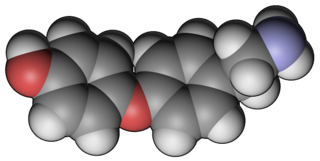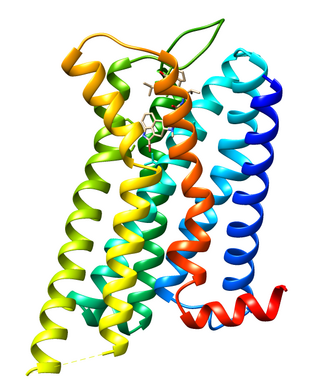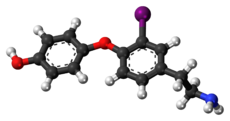
Monoamine neurotransmitters are neurotransmitters and neuromodulators that contain one amino group connected to an aromatic ring by a two-carbon chain (such as -CH2-CH2-). Examples are dopamine, norepinephrine and serotonin.

Phenethylamine (PEA) is an organic compound, natural monoamine alkaloid, and trace amine, which acts as a central nervous system stimulant in humans. In the brain, phenethylamine regulates monoamine neurotransmission by binding to trace amine-associated receptor 1 (TAAR1) and inhibiting vesicular monoamine transporter 2 (VMAT2) in monoamine neurons. To a lesser extent, it also acts as a neurotransmitter in the human central nervous system. In mammals, phenethylamine is produced from the amino acid L-phenylalanine by the enzyme aromatic L-amino acid decarboxylase via enzymatic decarboxylation. In addition to its presence in mammals, phenethylamine is found in many other organisms and foods, such as chocolate, especially after microbial fermentation.

Tryptamine is an indolamine metabolite of the essential amino acid, tryptophan. The chemical structure is defined by an indole—a fused benzene and pyrrole ring, and a 2-aminoethyl group at the second carbon (third aromatic atom, with the first one being the heterocyclic nitrogen). The structure of tryptamine is a shared feature of certain aminergic neuromodulators including melatonin, serotonin, bufotenin and psychedelic derivatives such as dimethyltryptamine (DMT), psilocybin, psilocin and others. Tryptamine has been shown to activate trace amine-associated receptors expressed in the mammalian brain, and regulates the activity of dopaminergic, serotonergic and glutamatergic systems. In the human gut, symbiotic bacteria convert dietary tryptophan to tryptamine, which activates 5-HT4 receptors and regulates gastrointestinal motility. Multiple tryptamine-derived drugs have been developed to treat migraines, while trace amine-associated receptors are being explored as a potential treatment target for neuropsychiatric disorders.
A biogenic amine is a biogenic substance with one or more amine groups. They are basic nitrogenous compounds formed mainly by decarboxylation of amino acids or by amination and transamination of aldehydes and ketones. Biogenic amines are organic bases with low molecular weight and are synthesized by microbial, vegetable and animal metabolisms. In food and beverages they are formed by the enzymes of raw material or are generated by microbial decarboxylation of amino acids.

Isoprenaline, or isoproterenol, is a medication used for the treatment of bradycardia, heart block, and rarely for asthma. It is a non-selective β adrenoceptor agonist that is the isopropylamine analog of epinephrine (adrenaline).
An autoreceptor is a type of receptor located in the membranes of nerve cells. It serves as part of a negative feedback loop in signal transduction. It is only sensitive to the neurotransmitters or hormones released by the neuron on which the autoreceptor sits. Similarly, a heteroreceptor is sensitive to neurotransmitters and hormones that are not released by the cell on which it sits. A given receptor can act as either an autoreceptor or a heteroreceptor, depending upon the type of transmitter released by the cell on which it is embedded.

Thyronamine refers both to a molecule, and to derivatives of that molecule: a family of decarboxylated and deiodinated metabolites of the thyroid hormones thyroxine (T4) and 3,5,3'-triiodothyronine (T3).

Trace amines are an endogenous group of trace amine-associated receptor 1 (TAAR1) agonists – and hence, monoaminergic neuromodulators – that are structurally and metabolically related to classical monoamine neurotransmitters. Compared to the classical monoamines, they are present in trace concentrations. They are distributed heterogeneously throughout the mammalian brain and peripheral nervous tissues and exhibit high rates of metabolism. Although they can be synthesized within parent monoamine neurotransmitter systems, there is evidence that suggests that some of them may comprise their own independent neurotransmitter systems.
Trace amine-associated receptors (TAARs), sometimes referred to as trace amine receptors, are a class of G protein-coupled receptors that were discovered in 2001. TAAR1, the first of six functional human TAARs, has gained considerable interest in academic and proprietary pharmaceutical research due to its role as the endogenous receptor for the trace amines phenethylamine, tyramine, and tryptamine – metabolic derivatives of the amino acids phenylalanine, tyrosine and tryptophan, respectively – ephedrine, as well as the synthetic psychostimulants, amphetamine, methamphetamine and methylenedioxymethamphetamine. In 2004, it was shown that mammalian TAAR1 is also a receptor for thyronamines, decarboxylated and deiodinated relatives of thyroid hormones. TAAR2–TAAR9 function as olfactory receptors for volatile amine odorants in vertebrates.

Dopamine receptor D2, also known as D2R, is a protein that, in humans, is encoded by the DRD2 gene. After work from Paul Greengard's lab had suggested that dopamine receptors were the site of action of antipsychotic drugs, several groups, including those of Solomon Snyder and Philip Seeman used a radiolabeled antipsychotic drug to identify what is now known as the dopamine D2 receptor. The dopamine D2 receptor is the main receptor for most antipsychotic drugs. The structure of DRD2 in complex with the atypical antipsychotic risperidone has been determined.

Trace amine-associated receptor 2 (TAAR2), formerly known as G protein-coupled receptor 58 (GPR58), is a protein that in humans is encoded by the TAAR2 gene. TAAR2 is coexpressed with Gα proteins; however, as of February 2017, its signal transduction mechanisms have not been determined.

Trace amine associated receptor 6, also known as TAAR6, is a protein which in humans is encoded by the TAAR6 gene.

Trace amine-associated receptor 5 is a protein that in humans is encoded by the TAAR5 gene. In vertebrates, TAAR5 is expressed in the olfactory epithelium.

Trace amine-associated receptor 8 is a protein that in humans is encoded by the TAAR8 gene. In humans, TAAR8 is the only trace amine-associated receptor that is known to be Gi/o-coupled.

Trace amine-associated receptor 1 (TAAR1) is a trace amine-associated receptor (TAAR) protein that in humans is encoded by the TAAR1 gene. TAAR1 is an intracellular amine-activated Gs-coupled and Gq-coupled G protein-coupled receptor (GPCR) that is primarily expressed in several peripheral organs and cells, astrocytes, and in the intracellular milieu within the presynaptic plasma membrane of monoamine neurons in the central nervous system (CNS). TAAR1 was discovered in 2001 by two independent groups of investigators, Borowski et al. and Bunzow et al. TAAR1 is one of six functional human trace amine-associated receptors, which are so named for their ability to bind endogenous amines that occur in tissues at trace concentrations. TAAR1 plays a significant role in regulating neurotransmission in dopamine, norepinephrine, and serotonin neurons in the CNS; it also affects immune system and neuroimmune system function through different mechanisms.

Trace amine-associated receptor 9 is a protein that in humans is encoded by the TAAR9 gene.

RO-5166017 is a drug developed by Hoffmann-La Roche which acts as a potent and selective agonist for the trace amine-associated receptor 1, with no significant activity at other targets. This is important for the study of the TAAR1 receptor, as while numerous other compounds are known which act as TAAR1 agonists, such as methamphetamine, MDMA and 3-iodothyronamine, all previously known TAAR1 agonists are either weak and rapidly metabolized, or have strong pharmacological activity at other targets, making it very difficult to assess which effects are due to TAAR1 activation. The discovery of RO-5166017 allows purely TAAR1 mediated effects to be studied, and in animal studies it was shown to prevent stress-induced hyperthermia and block dopamine-dependent hyperlocomotion, as well as blocking the hyperactivity which would normally be induced by an NMDA antagonist. The experiment was done in dopamine transporter knockout mice, and since TAAR1 affects the dopamine transporter, the results could be very different in humans.

EPPTB (RO-5212773) is a drug developed by Hoffmann-La Roche which acts as a potent and selective inverse agonist of trace amine-associated receptor 1 (TAAR1), with no significant activity at other targets. EPPTB is one of the first selective antagonists developed for TAAR1, and has been used to demonstrate an important role for TAAR1 in regulation of dopaminergic signalling in the limbic system. Although EPPTB has high affinity for the mouse TAAR1, it has much lower affinity for rat and human TAAR1, which limits its use in research. While the human and mouse forms of TAAR1 have similar functions and bind similar ligands, the actual binding affinities of individual ligands often vary significantly between the two versions of the receptor.

o-Phenyl-3-iodotyramine (o-PIT) is a drug which acts as a selective agonist for the trace amine-associated receptor 1. It has reasonable selectivity for TAAR1 but relatively low potency, and is rapidly metabolised in vivo, making it less useful for research than newer ligands such as RO5166017.
Thyromimetic drugs are synthetic agonists of the thyroid hormone receptor's isoforms TR α1, TRα2, TRβ1, or TRβ2, mimicking some or all of the effects of endogenously produced thyroid hormones that regulate metabolism. Some thyromimetic drugs are selective for various of these receptors over others, enabling more targeted effects and reducing toxicity. Thyromimetics selective for TRβ—including eprotirome, sobetirome, resmetirom, and the prodrug VK2809—have been investigated for the treatment of non-alcoholic fatty liver disease, dyslipidemia, and other metabolic and neurodegenerative diseases.













